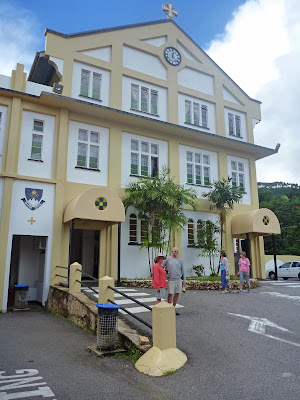St Vincent and the Grenadines is actually a group of islands
and we checked in at Union Island, stayed 3 nights at Tobago Cays and a few
nights in Bequia (pronounced Beckway) before checking out.
The Tobago Cays are the main draw to this area. These are a group of islands surrounded by a
protective reef system. The water is
blue and relatively clear. Every day small
boats come out from the main island selling ice, fresh fruit, bread, lobster,
conch and pretty much anything you would need.
This is very Caribbean and we will enjoy it as long as our wallets can
stand it. On average, prices are double what might be considered reasonable,
but we splurge when we don’t feel like taking the dingy to town. The whole area is a marine park. Taking any marine life is prohibited and they
charged us about $20 per day to anchor in the white sandy bottom. Every day we snorkeled and enjoyed the green and hawksbill
turtles and saw some fish life outside the reef.
From there we bypassed Canouan and stopped in
Bequia. This is a lovely town with clear
water and a nice main street. The town is lined with small crafts shops and Emily bought an Queen Triggerfish carved from whale bone. This is one of the few places where limited whaling is allowed using harpoons and open boats. They were quite proud to say they took the annual maximum limit of 4 whales this past season.
The snorkeling was good around the boat and Emily found an enormous hermit crab just under our boat.
They have
talented model shipbuilders here and we paid them a visit again. We talked with the owner and for a mere $2500
they could make me a scale model of Emily
Grace and ship it to me. My dear
Readers may want to take note of this since Christmas is coming up!
We checked out of Bequia and made an overnight run past St
Vincent and dropped anchor in Rodney Bay, St. Lucia. After two days, two kid boats caught up to us
here. One morning we hiked up Pigeon
hill with the crews and 4 kids from What
If and Polluxs to see Fort Rodney.
The hike was nice with good views of the surrounding area. We could see Martinique, just 4 hours to our
north. Emily is looking forward to heading
there since she will get new eyeglasses there.
St. Lucia also has great local vendors that come out to the
anchorage each day in small boats selling fresh fruits and vegetables. Here there are great dingy docks, major supermarkets,
hardware stores and marinas only a short dingy ride away. We managed to find a Butterball turkey, egg
nog and all the fixings for a Thanksgiving Day meal. Kim made her traditional
stuffing and even baked blueberry and mincemeat pies. We could have had a pumpkin pie, but since we
have found pumpkin everywhere, we opted for the extraordinary!
We had forgotten how easy Caribbean cruising was compared to
most of the countries we have visited.
Shopping, groceries and parts are always close by and shipping parts from
the USA is relatively easy if needed.
This “downhill” sail back to the US is welcome by both captain and crew.
Tom




























































